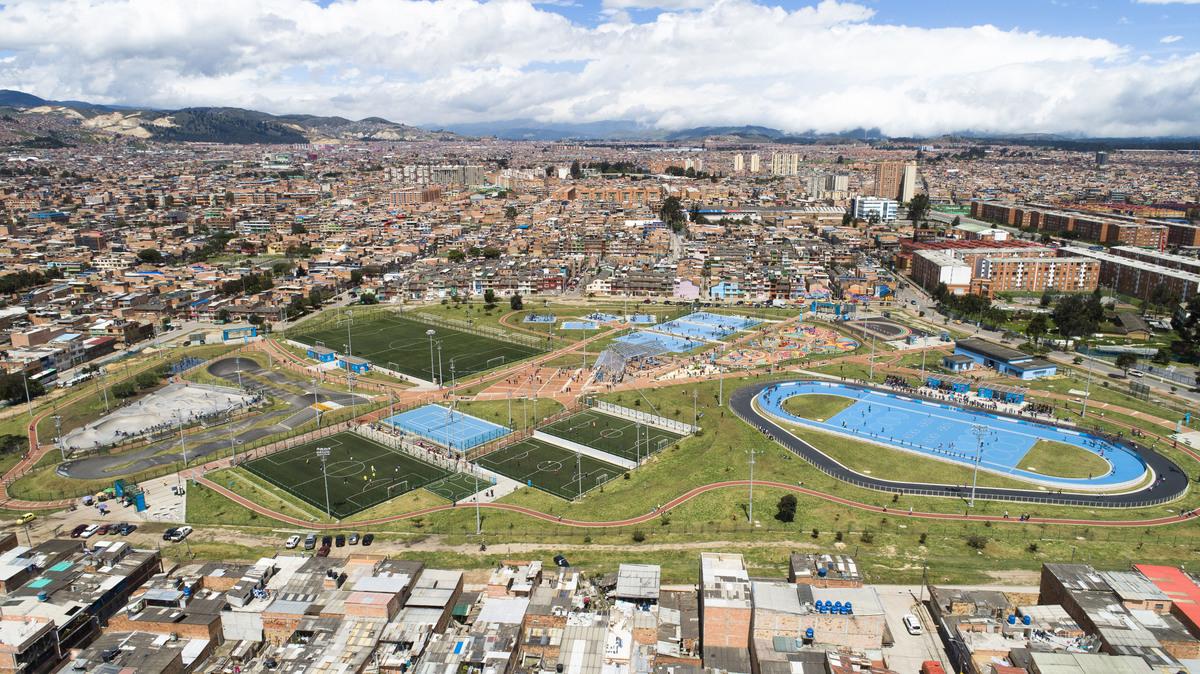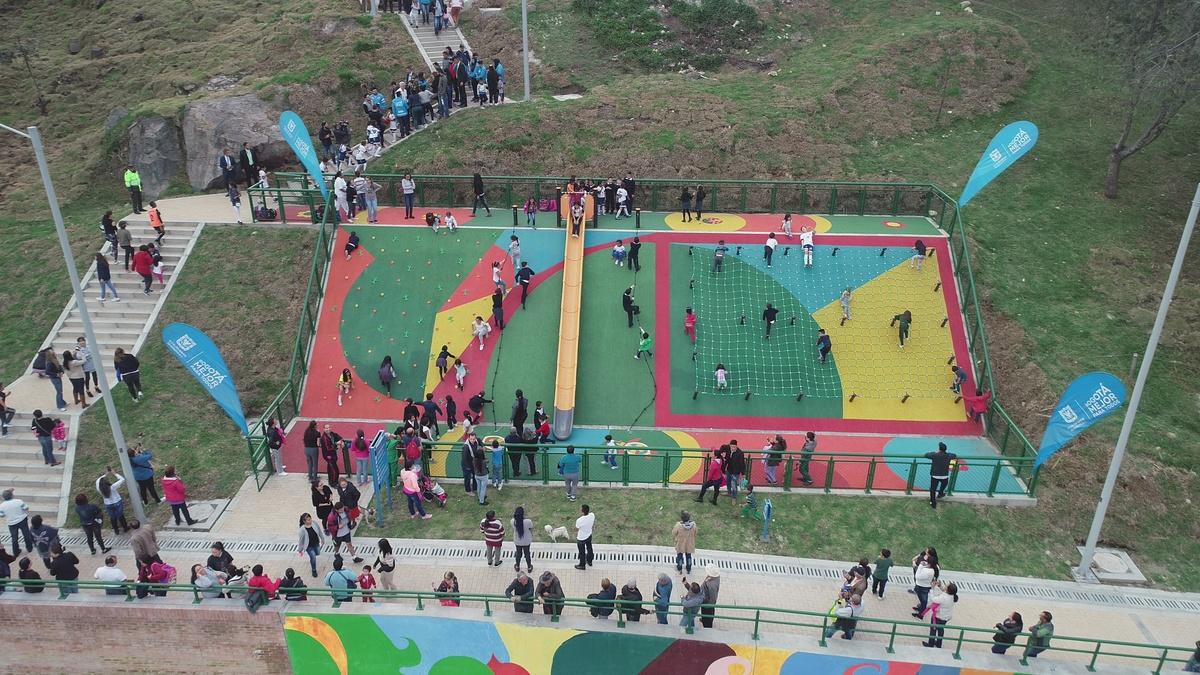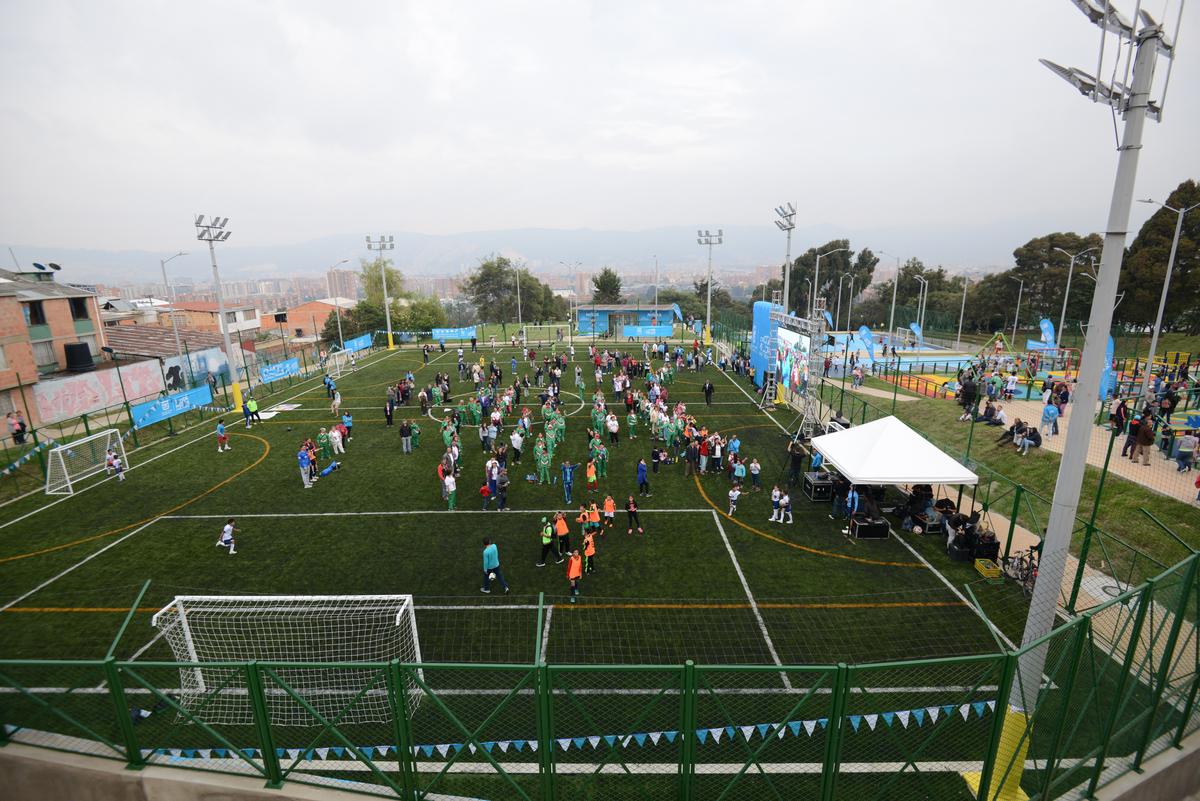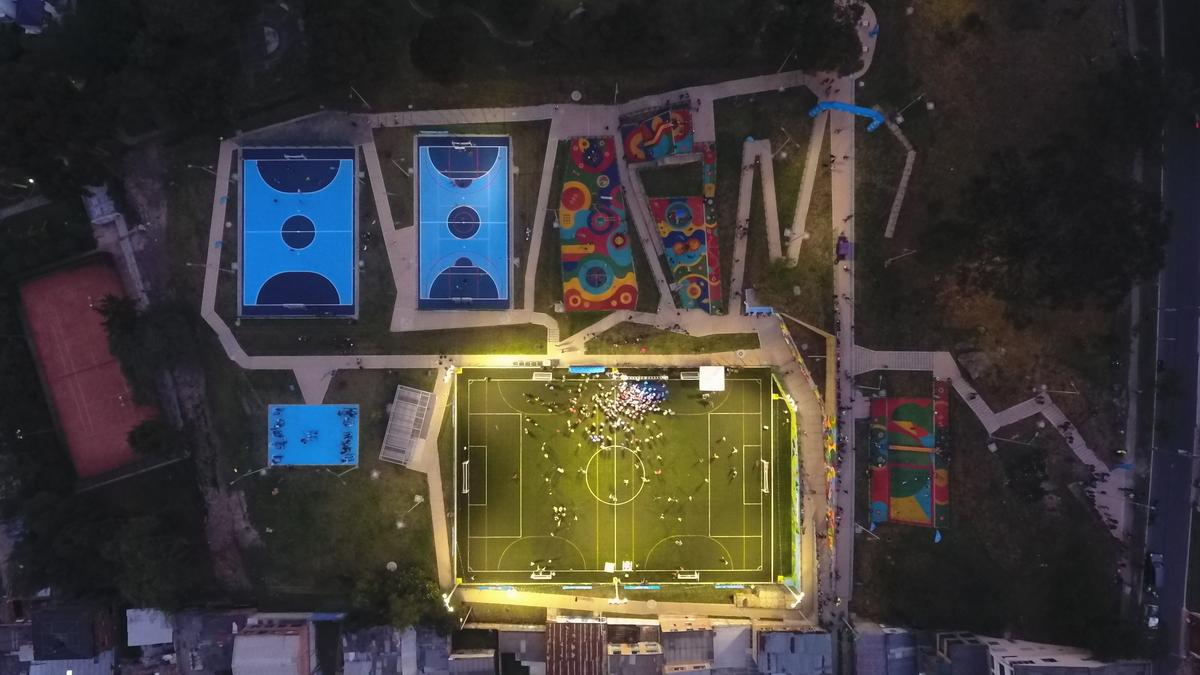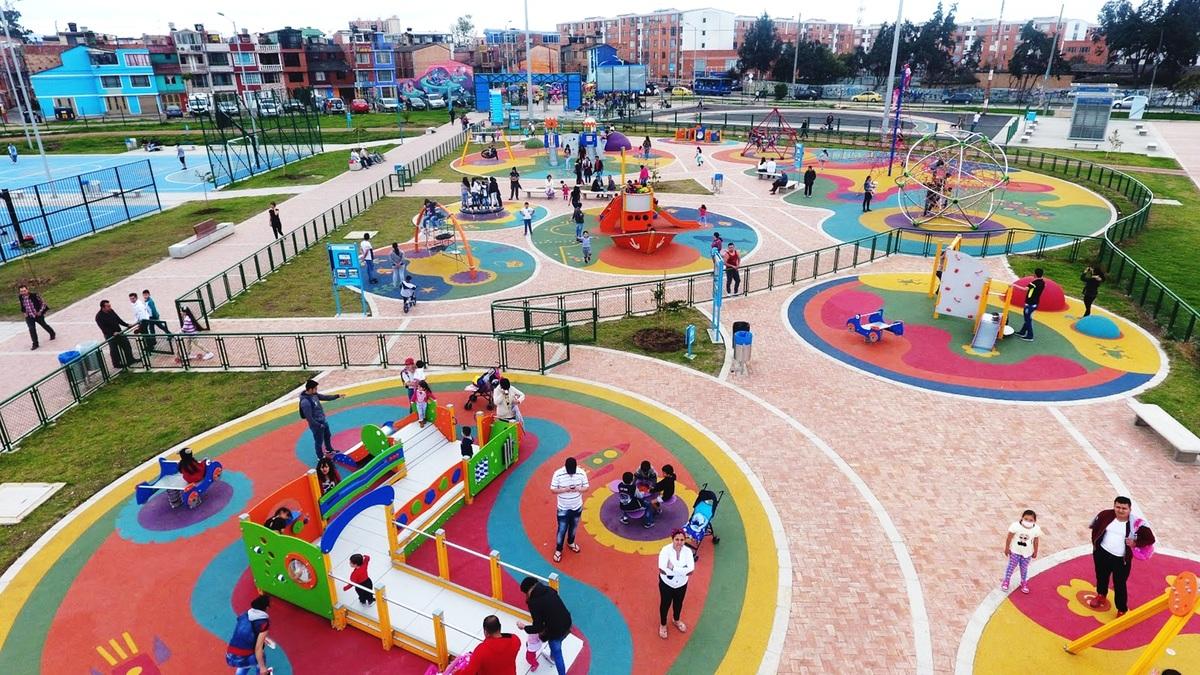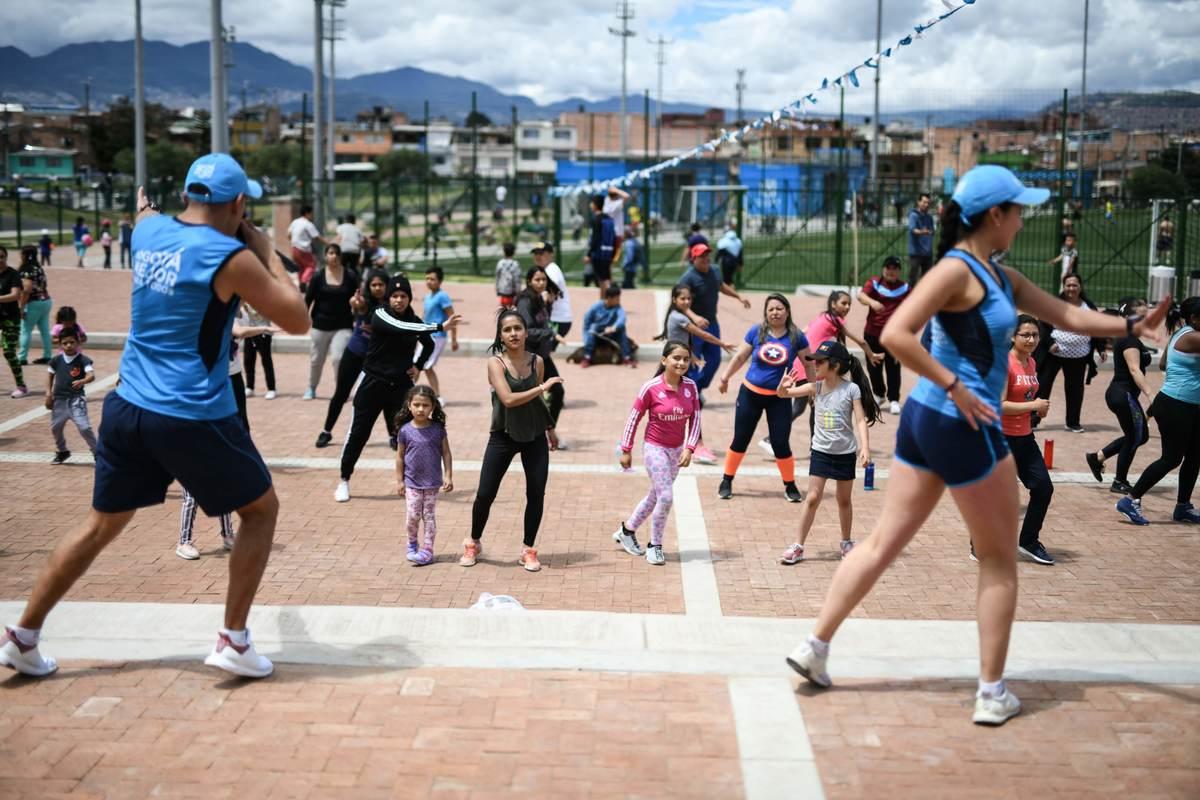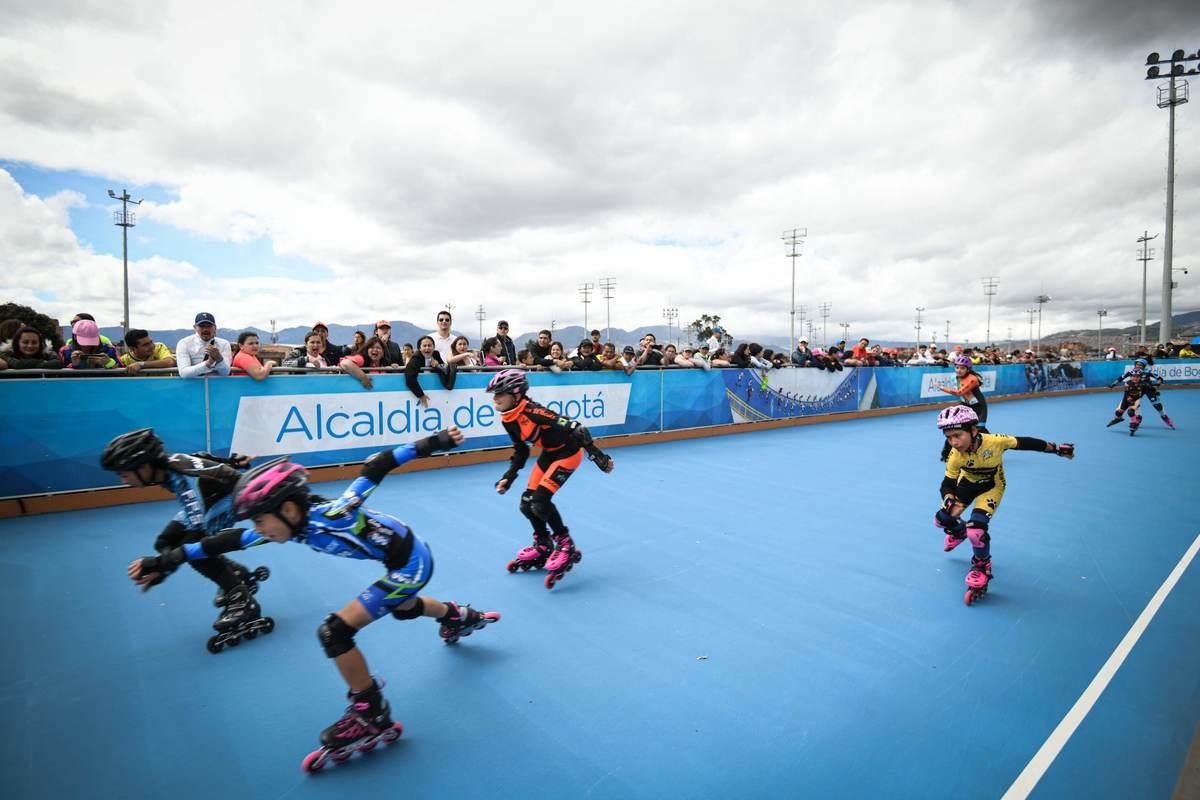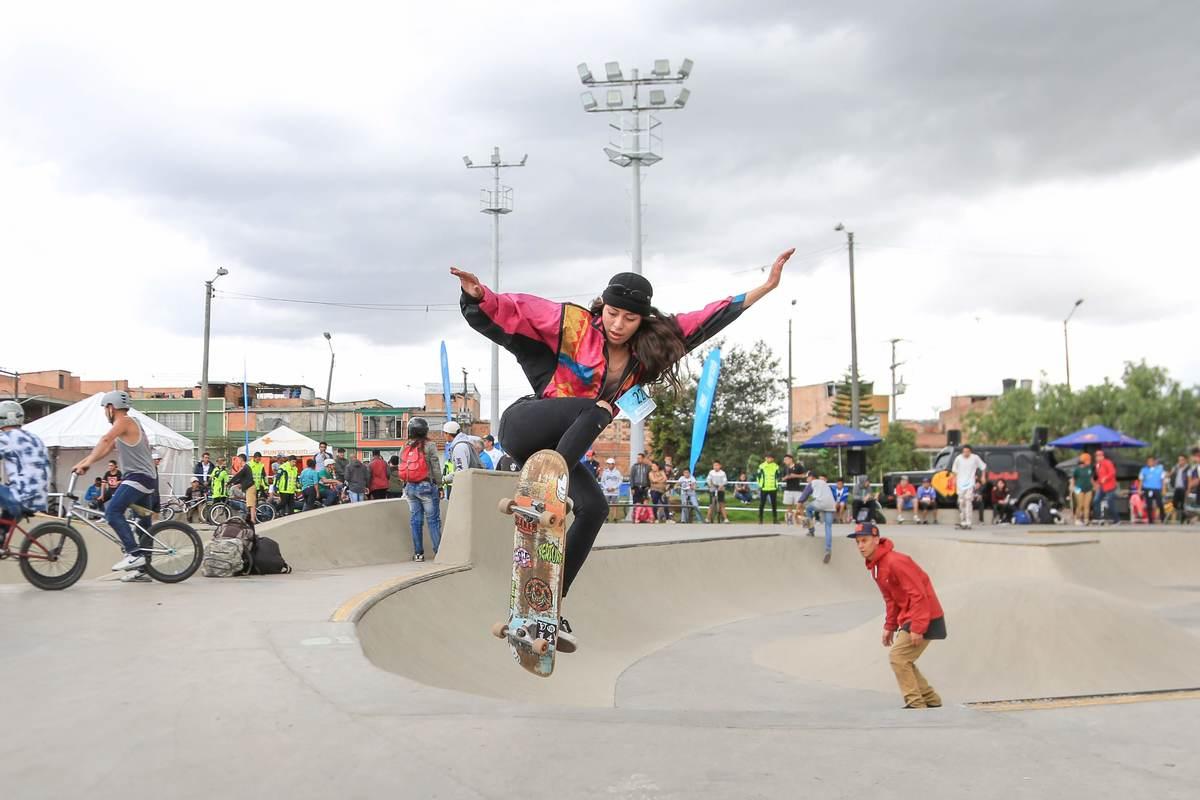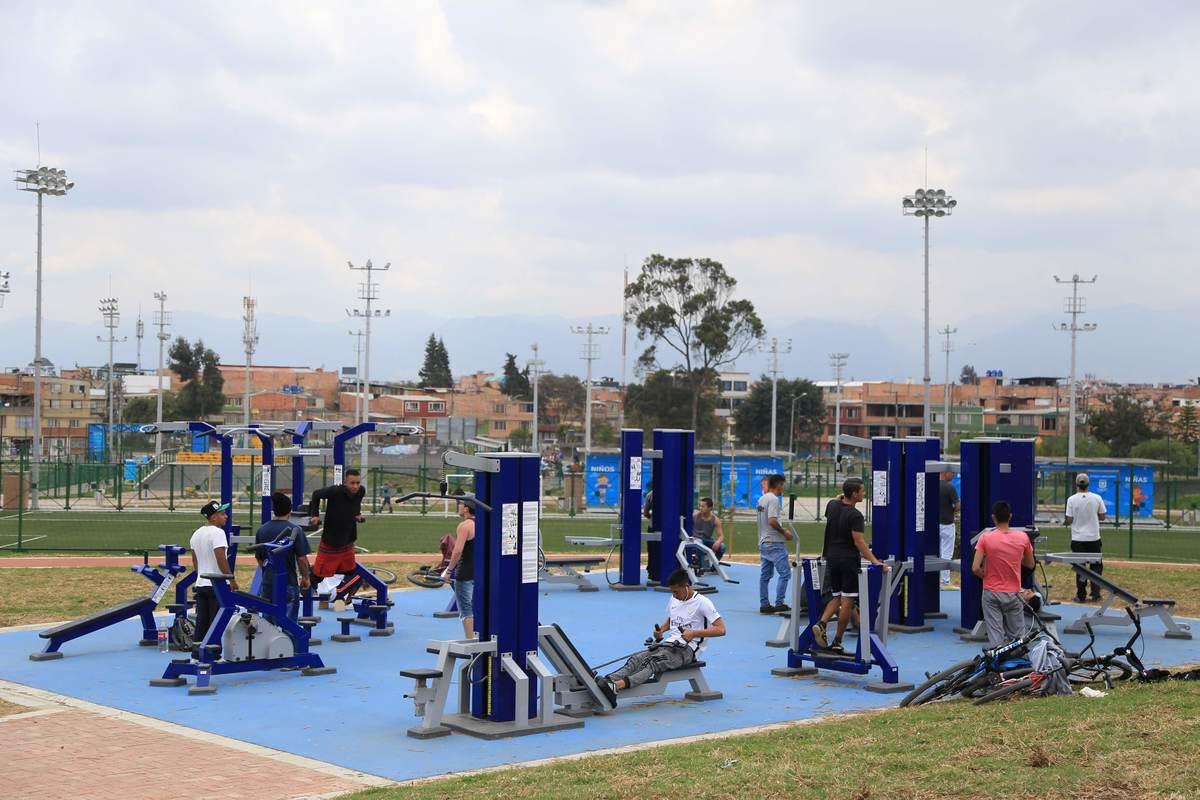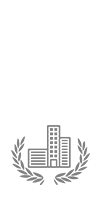Master Plan of Sports and Recreational Equipment for the city of Bogota
Last modified by the author on 12/07/2019 - 16:49
- Address 1 - street : 110111 BOGOTá , Colombia
- Population : 8 000 000 hab
- Number of jobs : 14 955 jobs
- Starting year of the project : 2016
- Delivery year of the project : 2019
- Key words : synthetic fields, sports scenarios, granular rubber, recycling, social inclusion, children areas, co2 reductions, insecurity, recreation, sports, health
-
1543 ha -
300 000 000 €
The Mayor's Office of Bogota Capital District of Colombia, has more than 8 million inhabitants distributed in 20 locations, which present significant indexes of insecurity in micro-trafficking, crime and consumption of SPA (Prevention of Psychoactive Substance Consumption) issues. Much of this problem is associated with levels of social inequality, poverty and lack of education, which is why this Administration has found through the construction, adaptation and maintenance of parks, recreational and sports scenarios a great opportunity to improve the quality of life of its inhabitants and combat these problems.
Parks are spaces of equality that are available to everyone, regardless of their social, economic or disability status. There are more than 1,100 parks that have been intervened during this Administration, in which the existing sports recreational offer allows that in one place, children have fun in children's games, young people do sport or physical activity in multipurpose gyms, sports fields, skating rink, BMX tracks and Skate Parks, among others. Additionally, the scenarios offer spaces for older adults to have a healthier life and perform physical activity in vital gyms, jogging or hiking trails. This improves the quality of life of citizens and promotes happiness and equity, some of the great commitments of Mayor Enrique Peñalosa with Bogotá.
Here are some of the most representative scenarios where there has been a significant change in the quality of life of citizens:
PARK ZONAL CASA BLANCA, Union of two realities:
- Area of intervention: 17,000 m2
- Synthetic soccer field 8 Night lighting
- Three playgrounds
- Outdoor gym area
- Chess and table tennis
- Dressing room
- Multiple court Asphalt with synthetic coating
- Water collector
- Night Lighting
- Schedule: the courts 6am - 6pm
- Total investment 7,370 million pesos (2M Euros)
- 330.000 people benefited approximately
In the middle of the last century, one of the main haciendas in the town of Suba was the Hacienda Casa Blanca, which, years later, was subdivided due to the demand for housing, which forced the urbanization processes, later becoming the White House neighborhood.
In its process of conurbanization, two sectors with socioeconomic differences were developed, on the one side was stratum 6 and on the other stratum 2. Through the POT 2004 (Territorial Ordinance Plan), the Zonal Casa Blanca park was established, attached to the ecological structure main city.
Before his intervention, 2 years ago, he had some games and sports areas that were in poor condition due to lack of maintenance. In addition, the inhabitants did not use the park due to the insecurity and drug consumption that was present in the area.
The Zonal White House Project started in 2017 and was delivered in March 2019.
The impact of this work speaks for itself with the smiles of thousands of people and the high volume of use of its inhabitants.
The tennis court that had been for the exclusive use of the residents of a group of houses is now in common use.
Today is where you start the dreams and aspirations of thousands of people who arrive from 5 in the morning to make use of their facilities, their synthetic football pitch adds an average of 50 thousand uses per year.
With its construction, the park has been appropriated by the community, thus displacing consumers and sellers of psychoactive substances that were previously established.
Now it allows the access of disabled people who can enjoy the recreational offer, improving its connectivity from the Av. Principal , Av. Suba, to the Casa Blanca neighborhood in a safe and accessible way.
Use Analyses
For the formulation of the designs surveys were made to define the vocation and use of the park. With the results, the interests of the community were defined into 5 modules: platforms, ecological, sports, multifunction and games, focused on the technical, urban, landscape and mobility requirements that the final design of the park should contain.
The following characteristics were identified from the results:
- People have a great preference for ecological activities aimed at environmental education, gardens and community gardens.
- The spaces should contemplate rest areas for all types of people, meeting points and activities aimed at promoting cultural spaces.
- The surveyed community has a greater preference for sports, such as: Football, basketball and volleyball.
- Respondents have a preference for directed activities such as aerobics and recreational gymnastics.
- The community of the sector has a greater preference for games aimed at children and outdoor gym machines, however in a large part of the surveyed people filled out marked all the options.
- Lighting points within the park and in the surroundings that allow the citizen to change the perception of insecurity generated by the area.
- Have an appropriate space for the different activities that will be carried out in the park, especially those that refer to high-impact activities such as skate and bicicrós where the safety of children, seniors and people with mobility is not put at risk reduced.
- Allow and facilitate access to all children, youth, adults, seniors and people with disabilities.
- Installation of stairs and ramps for access and transit within the park area.
- Installation of furniture for rest as chairs and benches.
- Include spaces for activities that are already carried out within the park such as the space for sports activities and the ecological point where the current ecological garden is taken into account.
ZONAL PARK GILMA JIMÉNEZ, From darkness to the light
- Area of intervention: 82,000 m2
- (4) Soccer Synthetic Fields 11,8 and (2) soccer 5
- (3) Multiple courts synthetic asphalt synthetic coating
- Asphalt Tennis Court Synthetic coating
- Skatepark
- Skating Rink
- BMX Track
- Gyms
- State-of-the-art children's games with rubber floor for their protection
- Children's Competition Track
- Arena
- Pedestrian Paths
- Jogging trail with rubber floor
- Service in Skating and Football Area 11
- Coffee shop on central square
- Access square. (Four porches for access)
- Central square
- Board games, Table tennis, Chess
- Lighting, includes electrical substation
- Hours: 24/7 5:30 am - 9:00 pm
- Total investment: $ 22,240. million (6M Euros)
- 570 thousand people benefited approximatel
The current Gilma Jiménez Park was acquired in the first Administration of Mayor Enrique Peñalosa in 1999, at that time it belonged to the Radio and Television company RCN. The land was in a state of neglect and had no lighting systems, so it lent itself to all types of criminal acts such as murder, rape and consumption of psychoactive substances.
For many years the community was pending the execution of a work that would benefit them and for the year 2005 there was a Master Plan, a planning tool destined to define the determinants of the park for their designs, which were ready in the year 2009
However, in 2014 the Master Plan was modified and in 2016 the designs were updated according to the guidelines and expectations of the current Administration.
The positive impact of this new sports recreation infrastructure is unprecedented in comparison with the volume of appropriation of the community.
Although it is recent delivery and operation since last March 27, 2019, the park remains full since its opening. At 5:30 am there are an average of 180 athletes of different disciplines to train and usually it remains active in all its zones and until its closure, which is at 9:30 p.m.
For its inauguration on June 15 there was a capacity of 15,000 attendees.
The park is named after Gilma Jiménez in order to honor the memory and legacy of the representative to the camera, who for years fought for the rights of children.
COMPONENT ANALYSIS
Before his intervention there were two micro-soccer courts, one basketball court, two areas with games for children and two buildings. The state of abandonment and poor state of its facilities, conditions of insecurity and accessibility, explain the lack of appropriation and influx of people.
The sport component, is the main component of this proposal the program seeks to have the vocation of the traditional sports of football and basketball while incorporating other equipment to encourage strengthening and expanding the sports offer with special emphasis on the population young. In this case the last case includes scenarios for the practice of other trend sports such as the Skatepark, skating rinks and BMX, promoting interest and physical activity in young people as a tool for social transformation.
Conclusions
In conclusion, the intervention and construction of parks generates dynamics in the social fabric of the neighborhoods, which contribute to preventing the problems of insecurity, criminal acts and drug consumption through quality sports and recreational spaces for all ages.
The District Institute of Recreation and Sports - IDRD, through the execution of investment project No. 1082 "Construction and adaptation of parks and equipment for all", promotes a vision of the city with inclusion, quality of life and physical health and mental through the intervention and construction of 1200 parks designed for all population groups (children, youth, adults and seniors, people with disabilities and vulnerable population).
The Master Plan for Sports and Recreational Equipment that responds to the National Sports Plan, is a first-level planning instrument that develops the Territorial Planning Plan that aims to offer parks and sports equipment according to the needs, preferences and sports recreation expectations of the population of Bogota, and seeks to articulate the interventions of construction and adaptation of sports infrastructure with the programs and sports projects of the IDRD in progress.
Programme
- Public facilities and infrastructure
- Public spaces
- Green spaces
CO2 Impact
47 030 tCO2
Method used to calculate CO2 impact
Reference Data: A reused tire reduces 67.85 Kg of CO2. *
To obtain a tonne of recovered rubber, approximately 120 Out of Use Tires (NFU) are needed.
Method Used: • Quantify the amount of areas destined for synthetic soccer fields and children's areas with rubber surfaces. (Courts 243.893M2 + Child Zone 65.200M2)
• Each M2 of synthetic field of 2cms of Thickness Equivales 17 kg of Recovered Rubber • Each M2 of Infant Zone of 3cms of Thickness Equivalent 25 kg of Recovered Rubber • Multiply the amount of M2 by the amount of Kg x M2 • The result is the total of Kg converted to tons of recovered rubber (5,776 tons).
• Of the amount of Tons, the total of recovered Tires is obtained (693,144)
• With the total number of tires you get the total of CO2 reductions * Integrated System of Management of Out of Use Tires, TNU. 2012. Polytechnic University of Madrid.
Project progress
- Delivery phase
- Operational phase
Procedure type
- Urban développement permit
Key points
- Governance
- Quality of life
- Economic development
- Mobility
- Smart city
- Resources
- Biodiversity
Approaches used
- Others
Certifications
- Autre
More info
https://youtu.be/wMGRQ-4cUtcData reliability
Self-declared
Type of territory
For Bogota, the capital of Colombia with more than 8 million inhabitants and with localities that present indices of insecurity in terms of micro-trafficking, crime and consumption of SPA (Prevention of the Consumption of Psychoactive Substances);It is for this administration an opportunity the intervention and construction of Parks by the District Institute of Recreation and Sports to generate an impact in the dynamics of the social fabric of the neighborhoods that contributes to prevent the situations mentioned above with sports and recreational spaces of quality forAll ages.It is a challenge for the city to meet this objective if its territory is considered to have mountain topography and, in turn, large wetlands for a vulnerable population concentrated in its peripheries, where the supply of quality public space is scarce due to the spontaneous growth of manyof these areas.
Climate zone
[Af] Tropical Wet. No dry season.
Land price
200 €/m²
More info
https://www.idrd.gov.cohttps://bogota.gov.co
Total investment costs (before tax)
300 000 000 € HT
Project holder
Project management
Project stakeholders
Instituto Distrital de Recreación y Deporte - IDRD
Construction manager
Mission: The IDRD promotes the exercise and full enjoyment of the right to sport, recreation, physical activity, the use of free time and the proper use of parks and scenarios for the inhabitants of Bogotá in order to contribute to the formation of better citizens, to teach the values of healthy competition and to improve the quality of life in harmony with the ecosystems, the defense of the public and the environment that makes Bogota a more participative, active and inclusive city.
atncliente(a)idrd.gov.co
https://www.idrd.gov.co
Quality of life / density
The transformation of the city of more than 8 million through its parks has given the poorest and most isolated sectors of the population new leisure options, reducing the social gap and its opportunities. Today the most vulnerable population of the city has access to synthetic courts, playgrounds, jogging trails and exercise areas, with a granular base of rubber. Its appearance and functionality stimulate its use and paradigms are eliminated regarding the quality of these spaces and their location, usually associated with sectors of greater economic capacity.
Culture and heritage
The implementation of the parks has revitalized their surroundings and promotes on their facilities the use of diverse activities of citizen integration; cultural events, music, art, aerobics sessions, yoga among others. Vital spaces for the interaction and interaction of the inhabitants and their personal motivations. The cultural and sporting diversity is part of the investment plan, where it explicitly talks about the integration of new sports trends in its bicycle, board, skates, wall and skating rinks. The gymnasiums, which in general are the most requested type of equipment, make us see and think about the needs of all, and as from the policy of parks a direct and forceful impact is achieved in the cultural conformation of a territory, the sports culture. Bogota's growth and conurbation process divides it territorially into 20 localities with heritage sectors and properties that are characterized by their limited and limited supply of public space and sports venues, even though they are identified and intervened with the same needs as the others. The Patrimonial sectors and their properties usually represent a greater effort due to their patrimonial and conservation character by district and national administrative entities, but also intervened for the construction of the social fabric.
Social diversity
The current supply of parks does not offer the goods and spaces required for the realization of the recreational and sports needs of the inhabitants, the endowments of the parks are intended mainly for young people and young adults. The supply of endowments for children, women, the disabled and the elderly is restricted.
The survey carried out for the formulation of the Recreational and Sports Equipment Master Plan made it possible to show that, although in general the levels of dissatisfaction with the parks are low, the highest percentages of unsatisfied population are concentrated in the neighborhood scale parks and have to do with with the structures offered by the park and not so much with aspects such as the number of parks or their location in relation to housing. It is clear that the requirement and detailed analysis of the population, has allowed us to give a better response to the need, as an example in the case of gyms no substantial differences are presented if discriminated by age group; while if this request is considered by gender, women have an advantage with 54%, over men who reach 49%.
Social inclusion and safety
The intervention of these parks generates new dynamics in their environment, recreation and sports are promoted and in their reactive development the commerce and the local economy, vandalism decreases due to the lack of appropriation and use of the parks, they are illuminated and eliminated pockets of possible vandalism. Expenditure and Drug Consumption. A new opportunity stimulates a whole community, the renewed infrastructures of recreation and sport give an option and the way to the young people that for the lack of them fall in the middle of vice and the drug business. The new parks are a preventive and corrective tool for citizens. Careful Participation: Within the strategies implemented to ensure the participation of the entire beneficiary community of the 1200 parks that have been intervened during this administration. The administration Implements a Social Management Plan that ensures that citizens know, participate and follow up the Parks that are being built from the Studies and Designs Stage, inviting them to three open call meetings where a diagnosis is made to know the uses and needs of the Park to intervene. In the work stage, the participation strategies that are implemented are the meetings of open call for the whole community of the area of influence of the Park that are made at the beginning of work, when 50% of progress is reached and for the completion in the 95%. In addition, the creation of a Citizen Participation Committee that is integrated by the leaders and representatives of the Community Action Boards and those in charge of replicating the information with other citizens is promoted. This committee is invited every month to a follow-up meeting where the progress of the work is presented and where all the leaders can contribute their suggestions and clarify the doubts. Within the Social Management Plan there is a program aimed at hiring vulnerable population within the works: Employment Generation Program: the contractor is obliged to hire a percentage of 3 to 10% of Unqualified Labor in the area that corresponds to vulnerable population (mothers head of household, strata 1 and 2).
Ambient air quality and health
Air is an emergency in Bogotá due to the relationship between levels of pollution and diseases. "It is clear that there is a relationship between the increase in concentrations of pollutants and a huge variety of respiratory diseases, cardiopulmonary, and even with premature mortality," he said.
- The intervention of parks encourages the planting and management of green cover in the City and its ecological network united with each project, improving the production of oxygen in the city and reducing the production of dust in the areas of direct intervention and in general the depressed areas that lack paved roads.
- The reuse of NFU reduces CO2 emissions by reusing 1'100,000 used tires, which is equivalent to a decrease of 67'85 Kg per tire. The construction of 100 synthetic grass courts equals 1'100,000 tires, which represents the reduction of 74,635 tons of CO2 to the atmosphere, represented by a significant reduction of greenhouse gases.
Ambient:
- Collection and Handling Plan for Out of Use NFU Tires. These actions significantly reduce the generation of solid waste and their final disposal and a lower occupation of landfills. The material coming from the collection and recycling of the NFU are used for the construction of Sports and Recreational surfaces.
- Significant water savings when not required in the maintenance of synthetic grass.
- No use of chemical fertilizers or pesticides in the maintenance of synthetic grass, preventing its deterioration and contamination of soil and groundwater.
Health:
- Intalaciones and esceanarios Sports and Recreational for the physical development of all the community.
- HTTPS://WWW.IDRD.GOV.CO/MUEVETE-BOGOTA
SOLUTIONS
- Urban densification
- Proximity services
- Security
- Air quality
- Noise exposure
Implementation of Sports and Recreational Rubber Surfaces from Non-Use NFU Tires for Social
Through the Master Plan of Sports and Recreational Equipment for the city of Bogota Capital of Colombia with more than 8 million inhabitants, the implementation of granular rubber material was achieved with which a significant CO2 reduction is achieved for the city with the use of the out-of-use tires which are used as construction material for synthetic soccer fields, children's protection zones, exercise areas and pedestrian paths.
This administration has complied with the intervention of 1113 parks since 2016 achieving a transformation of the city with inclusion and equal opportunities; With the implementation of rubber as a material for the network of parks, sports and recreational areas, CO2 emissions are significantly reduced, with an environmental, social and administrative impact. With the plan of use of tires out of use (NFU) not only reduce CO2 emissions are significantly reduced the generation of solid waste and disposal of them and a lower occupation of landfills.Finally, with the implementation of sports parks and venues, security is improved with defined and illuminated areas, eliminating pockets of illicit activities, reactivating trade and the local economy and encouraging recreation and sports in young people by reducing interest of the sale and consumption of drugs.47 030,00 tCO2
Local development
In the IDRD, different actions are being implemented as part of the Social Management Plan that favor local development such as:
- Like the Job Generation Program that requires each contractor to hire unskilled labor from the area, with percentages that vary between 10% and 25% according to the investment in the work.
- Administration of Coffee Modules, at the moment the work stage ends and the Park is delivered for its use, the Subdirectorate of Parks and Scenarios performs the convenience assessment for the administration of coffee modules, having as a requirement that the people administer it within the area of influence of the Park.
- As parks are intervened and put into operation, new dynamics are generated in their surroundings, recreation and sports are promoted, and in their reactive development, commerce and the local economy.
Mobility strategy
Despite its mobility problems, Bogotá is the best city in Latin America for cyclists. This is one of the conclusions of a study by the Inter-American Development Bank (IDB) in 56 cities of the region, which led to the construction of 27 indicators on the use of bicycles and the policies that encourage the use of this means of transport. mostly non-motorized manages the management of the city of Bogotá.
Of the 2,513 kilometers of bike paths that exist in the continent, Bogotá has 392, which makes it the city with the greatest number of routes for the transit of cyclists. The capital of Colombia surpasses cities such as San Pablo (271) and Buenos Aires (130); and it is the place where more people travel by bicycle daily, since about 611,000 trips are made, while in Santiago de Chile 510,000 are made and in Mexico City 433,000.
Article 252 of the Land Management Plan (Decree 190 of 2004) mentions the Obligatory and content of the Master Plans for the parks and their connectivity with the pedestrian circulation, recreational bike paths, vehicular circulation as part of their Mobility analysis.
All the interventions take into account the content of the bicycle route regardless of its scale; however, not all of them are directly connected to the urban system of bicycle routes and many of the bicycle route interventions are carried out in coordination with the IDU Urban Development Institute, as they are responsible for the design of road profiles which include the bicycle according to its connectivity and context.
SOLUTIONS
- Soft transportation
- Other
Cycling Plan
In Bogotá, specific actions have been taken to promote sustainable mobility and the use of bicycles. 480 kilometers have been built for the means of transport and an extension of 120 kilometers is expected. The Bici Plan was formulated, which has five components: infrastructure, security, environment and health, institutionality; and promotion and culture. In the same way days without a car are promoted and sustainable driving or eco-driving that allows reducing emissions.
The system of bike paths for the city of Bogota is an alternative Moviliad solution for citizens which provides health and wellbeing by encouraging exercise and avoiding the use of polluting vehicles thus reducing CO2 emissions.Smart City strategy
Alcaldía Peñalosa has been working to install 57 free Internet zones throughout the city, prioritizing parks and tourist areas.
In total, the Mayor's Office will install 250 public connectivity zones, through public and private partnerships and alliances.
Representative areas such as the Simón Bolívar Park, the Plaza de Bolívar, the journalists' park, the Plazoleta del Chorro de Quevedo, the Plazoleta del Rosario and the Gold Museum will have free Wi-Fi.
This work is aimed at an infrastructure line that is part of the National Public Policy of the Ministry of Information Technologies and ICT Communications that is moving towards the democratization of Internet access.
Water management
The synthetic courts generate a significant saving of water since it is not necessary for irrigation. In the 100 courts built in the District, 93,516 cubic meters of potable water have been saved in maintenance. This saving is equivalent to the water consumption of 3,340 people in a year in Bogotá
Soil management
The non-use of chemical fertilizers and pesticides, required for conventional maintenance, prevents diseases and pests in natural grass that deteriorate the quality of the same and reduces the contaminated solid waste (chemical containers), contribution of pollutants to the environment and prevents pollutionof groundwater and soil.
Biodiversity and natural areas
Biodiversity: The intervention of the District parks includes a forest inventory that determines the current phytosanitary status of the existing vegetation and the actions to be taken within which the planting of new tree species that have the appropriate characteristics for their adequate growth and development is promoted. in terms of soil, climatic conditions and adaptation, which allow strengthening and protecting the main ecological structure, in order to maintain an eco systemic balance. Additionally, for new tree species that are planted, public safety aspects are taken into account, such as the type of stem or trunk, which must be high and without branches or intermediate foliage that generate spaces in which there is no visibility for the people who circulate in the parks.




